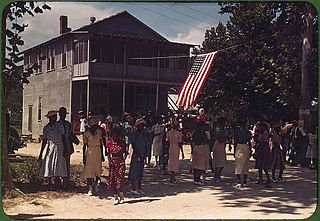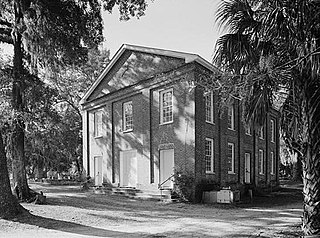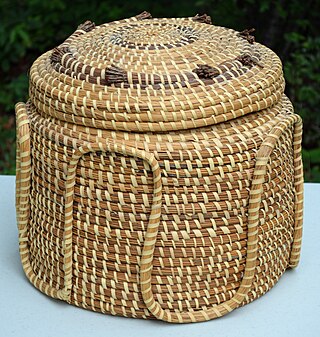Navassa is a town in Brunswick County, North Carolina, United States. The population was 1,505 at the 2010 census, up from 479 in 2000.
Navassa is part of the Wilmington, North Carolina metropolitan area.

Gullah is a creole language spoken by the Gullah people, an African-American population living in coastal regions of South Carolina and Georgia as well as extreme northeastern Florida and the extreme southeast of North Carolina.

The Gullah are an African American ethnic group who predominantly live in the Lowcountry region of the U.S. states of South Carolina, North Carolina, Georgia, and Florida within the coastal plain and the Sea Islands. Their language and culture have preserved a significant influence of Africanisms as a result of their historical geographic isolation and the community's relation to their shared history and identity.

The Sea Islands are a chain of tidal and barrier islands on the Atlantic Ocean coast of the Southeastern United States. Numbering over 100, they are located between the mouths of the Santee and St. Johns Rivers along the coast of South Carolina, Georgia, and Florida. The largest of these is Johns Island in South Carolina. The Sea Islands, particularly Sapelo Island, are home to the Gullah people. The islands are very acutely threatened by sea level rise due to climate change.

St. Helena Island is a Sea Island in Beaufort County, South Carolina, United States. The island is connected to Beaufort by U.S. Highway 21. The island has a land area of about 64 sq mi (170 km2) and a population of 8,763 as of the 2010 census. It is included as part of the Hilton Head Island-Beaufort Micropolitan Area. The island is renowned for its rural Lowcountry character and being a major center of African-American Gullah culture and language. It is considered to be the geographic influence behind the children's television program Gullah Gullah Island.

Daufuskie Island, located between Hilton Head Island and Savannah, is the southernmost inhabited sea island in South Carolina. It is 5 miles (8 km) long by almost 2.5 miles (4.0 km) wide – approximate surface area of 8 square miles (21 km2). With over 3 miles (5 km) of beachfront, Daufuskie is surrounded by the waters of Calibogue Sound, the Intracoastal Waterway and the Atlantic Ocean. It was listed as a census-designated place in the 2020 census with a population of 557.

The Lowcountry is a geographic and cultural region along South Carolina's coast, including the Sea Islands. The region includes significant salt marshes and other coastal waterways, making it an important source of biodiversity in South Carolina.

Marquetta L. Goodwine is an author, preservationist, and performance artist who serves as Queen Quet, Chieftess of the Gullah/Geechee Nation.
Emory Campbell is a community leader among the Gullah people, African Americans who live in the coastal low country region of South Carolina and Georgia. The Gullahs have preserved more of their African linguistic and cultural heritage than any other black community in the US.
Mandarin is a neighborhood located in the southernmost portion of Jacksonville, in Duval County, Florida, United States. It is located on the eastern banks of the St. Johns River, across from Orange Park. It's a short drive south of Jacksonville's city center, and is bordered by Beauclerc to the north, Julington Creek to the south and St. John's River to the west.

Atlantic Creole is a cultural identifier of those with origins in the transatlantic settlement of the Americas via Europe and Africa.

McLeod Plantation is a former slave plantation located on James Island, South Carolina, near the intersection of Folly and Maybank roads at Wappoo Creek, which flows into the Ashley River. The plantation is considered an important Gullah heritage site, preserved in recognition of its cultural and historical significance to African-American and European-American cultures.

Joseph A. Opala, OR is an American historian noted for establishing the "Gullah Connection," the historical links between the indigenous people of the West African nation of Sierra Leone and the Gullah people of the Low Country region of South Carolina and Georgia in the United States.

The Penn Center, formerly the Penn School, is an African-American cultural and educational center in the Corners Community, on Saint Helena Island. Founded in 1862 by Quaker and Unitarian missionaries from Pennsylvania, it was the first school founded in the Southern United States specifically for the education of African-Americans. It provided critical educational facilities to Gullah slaves freed after plantation owners fled the island, and continues to fulfill an educational mission. Leigh Richmond Miner photographed students and activities at the school.
Sierra Leonean Americans are an ethnic group of Americans of full or partial Sierra Leonean ancestry. This includes Sierra Leone Creoles whose ancestors were African American Black Loyalists freed after fighting on the side of the British during the American Revolutionary War. Some African Americans trace their roots to indigenous enslaved Sierra Leoneans exported to the United States between the 18th and early 19th century. In particular, the Gullah people of partial Sierra Leonean ancestry, fled their owners and settled in parts of South Carolina, Georgia, and the Sea Islands, where they still retain their cultural heritage. The first wave of Sierra Leoneans to the United States, after the slavery period, was after the Sierra Leone Civil War in the 1990s and early 2000s. According to the American Community Survey, there are 34,161 Sierra Leonean immigrants living in the United States.

Hog Hammock is an African-American community on Sapelo Island, a barrier island of the U.S. state of Georgia.

Haint blue is a collection of pale shades of blue-green that are traditionally used to paint porch ceilings in the Southern United States. Hex #D1EAEB is a popular shade of haint blue.
The Gullah are African Americans who live in the Lowcountry region of the U.S. states of Georgia, Florida, and South Carolina.
Griffin Lotson is an African-American historian, born in Crescent, Georgia. He is a seventh-generation Gullah Geechee. He serves as a councilman and the mayor pro-tem in Darien, Georgia. He also manages the Geechee Gullah Ring Shouters. He is the national Federal Government vice-chairman and former treasurer of the federal Gullah Geechee Cultural Heritage Corridor Commission.

The Gullah are African Americans who live in the Lowcountry region of the U.S. states of Georgia, Florida, South Carolina, and North Carolina, in both the coastal plain and the Sea Islands. They developed a creole language, also called Gullah, and a culture with some African influence.
















